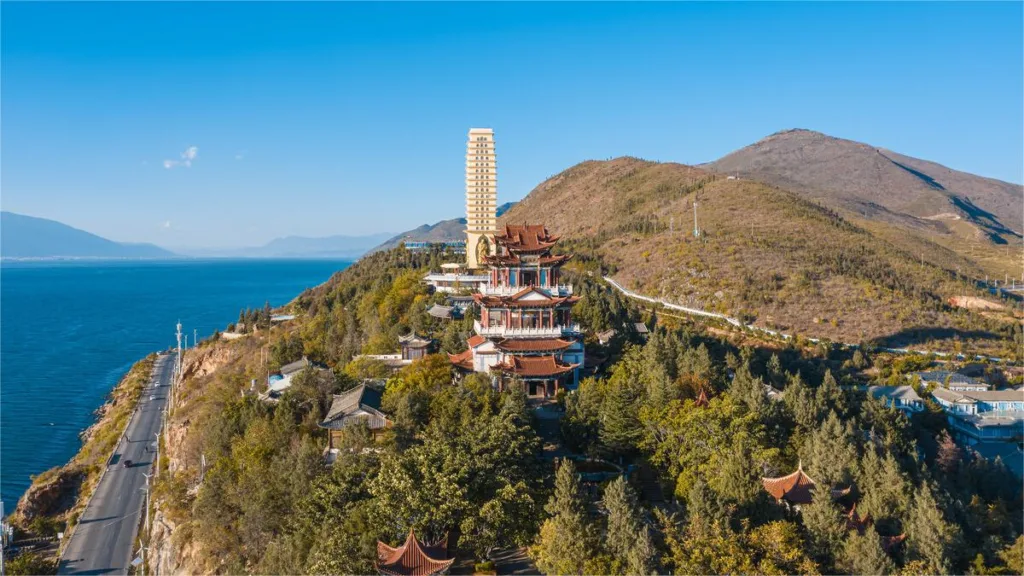Tianjing Pavilion, Dali – Ticket, Opening Hours, Location, and Highlights


The Tianjin Pavilion (天镜阁), which can be translated in Sky Mirror Pavilion, stands proudly on the Luoquan Peninsula, on the eastern shore of Erhai Lake in Dali, Yunnan Province. With its unique location, surrounded by water on three sides and nestled against the cliffs, the pavilion commands a stunning view of the lake. Constructed during the Ming Dynasty, it was named the “Tianjing Pavilion” and became one of the four renowned pavilions around Erhai Lake.
Throughout history, the Tianjin Pavilion has suffered damage and destruction. However, in 1996, the government undertook a meticulous reconstruction project, resulting in the magnificent structure that stands today. Visitors to the Tianjin Pavilion can immerse themselves in the enchanting melodies of the Bai ethnic group’s “Dabenqu” songs performed by local folk artists. They can also indulge in the exquisite flavors of Bai cuisine, with dishes centered around the famed Erhai Lake fish.
Índice
Información básica
| Duración estimada de la visita | 1 hora |
| Precio del billete | 30 RMB |
| Horario de apertura | 7.30 - 17.30 |
| Número de teléfono | 0086-0872-247-9517 |
Ubicación y transporte
The Tianjin Pavilion is situated on the Luoquan Peninsula, on the eastern shore of Erhai Lake in Dali, Yunnan Province, near Jinsuo Island. It is approximately 25 kilometers from Dali Railway Station by land and 10 kilometers from Dali Port by water, facing Dali Ancient City across Erhai Lake. Visitors can take a minibus from the Xiaguan Bus Terminal (下关汽车客运站) to Wase (挖色), disembarking at the Luoquan Peninsula Scenic Area (罗荃半岛景区) in Haidong Town (海东镇). However, it is highly recommended to travel by car or bicycle for a more convenient and enjoyable experience.
Highlights of Tianjing Pavilion
Buddhist Site

The pavilion itself is a four-story, octagonal structure towering atop the mountain peak. Its architectural style is distinctively Bai, featuring flying eaves, intricate brackets, and upturned corners—a masterpiece of ethnic architecture. The plaque bearing the inscription “般若波罗 (Prajna Paramita)” aptly illustrates that the Tianjin Pavilion is a Buddhist temple of the ancient Dali Kingdom, a prominent site of the Bai ethnic group’s Tibetan Buddhism. It stands in harmony with the nearby Luoquan Temple, which houses the Mahavira Hall and the Master Pilu Hall. During the periods of the Nanzhao and Dali Kingdoms, this area held significant influence as a sacred Buddhist site. During festivals such as the Guanyin Festival, the Buddha Festival, the Shuanghai Festival, the Xinghui Festival, and the Torch Festival, pilgrims and tourists alike flock here, creating a vibrant atmosphere.
“Stone Donkey” Legend

Not far from the Tianjin Pavilion, in the lake, lies the mythical “Stone Donkey” from the Bai ethnic legend “Clouds of Longing for Her Husband.” Legend has it that a beautiful princess named Afeng fell in love with a hunter named Along. Forbidden by her father, Afeng and Along eloped to Cangshan Mountain. To protect Afeng from the cold, Along flew to the east sea and stole the cassock of the Luoquan monk. Unfortunately, Along was caught in the monk’s spell and turned into a stone donkey at the bottom of the sea. Upon hearing the news, Afeng died of sorrow and transformed into a white cloud, drifting above Yujufeng Peak, gazing longingly at Along. Every autumn and winter, the phenomenon of “Clouds of Longing for Her Husband” appears above Cangshan Mountain, causing waves on Erhai Lake, and boats dare not sail – locals refer to it as the “Undrossable Cloud.”
Atracciones de Dalí, Lugares históricos de Yunnan